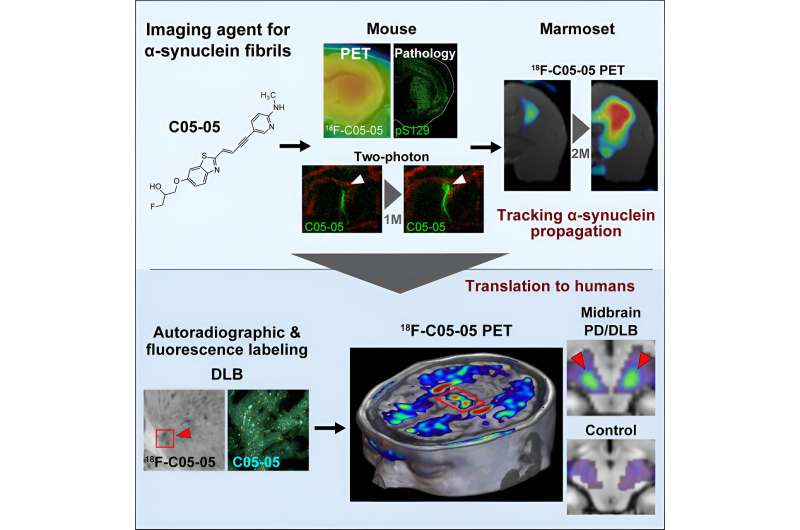This article has been reviewed according to Science X's editorial process and policies. Editors have highlighted the following attributes while ensuring the content's credibility:
fact-checked
peer-reviewed publication
proofread
Visualizing core pathologies of Parkinson's disease and related disorders in live patients

In countries with an aging population, neurodegenerative disorders such as Parkinson's disease (PD) and dementia with Lewy bodies (DLB) are becoming more prevalent. These conditions, for which no definitive cure currently exists, are extremely difficult to diagnose accurately while the affected person is still alive. This has proved to be a major roadblock for researchers seeking to assess potential therapies, since they have no conclusive way to check whether their proposed treatment is truly working in either patients or animal models.
Like Alzheimer's disease, a hallmark symptom in PD and DLB is the abnormal accumulation of certain protein structures. In PD and DLB, these aggregates are known as α-synuclein fibrils, which spread throughout the brain and cause damage to neural pathways.
Many scientists are trying to develop chemical agents that can selectively bind to α-synuclein and make it detectable via techniques such as positron emission tomography (PET). While a few studies have seen some success with this approach, there are still no PET tracers for α-synuclein that can be used in clinical practice to diagnose PD and DLB in living patients. This is mostly because α-synuclein deposits are small and not overly abundant.
Recently, as reported in a new study published in the journal Neuron on June 5, 2024, a team of scientists from Japan has designed a potentially game-changing PET tracer for α-synuclein.
The team was led by Senior Researcher Hironobu Endo from the Advanced Neuroimaging Center, Institute for Quantum Medical Science, and included Dr. Maiko Ono from the Institute for Quantum Life Science and Dr. Makoto Higuchi from the Advanced Neuroimaging Center, Institute for Quantum Medical Science, all based at the National Institutes for Quantum Science and Technology (QST).
The researchers first screened various potentially useful compounds that were selected based on prior knowledge. After a series of preliminary experiments in vitro, they found that a compound derived from PBB3—typically used to detect tau protein aggregates in Alzheimer's disease—was quite useful in visualizing α-synuclein. The team labeled this chemical, (E)-1-fluoro-3-((2-(4-(6-(methylamino)pyridine-3-yl)but-1-en-3-yn-1-yl)benzo[d]thiazol-6-yl)oxy)propan-2-ol, as C05-05.
Through extensive tests performed in two different animal models, namely mice and marmosets, the researchers showcased the high binding affinity and selectivity of C05-05 to α-synuclein. More specifically, C05-05 was used to analyze the quantity and distribution of these harmful protein deposits in various areas of the brain at different stages of disease progression.
Remarkably, C05-05 could also be used at the single-cell level via two-photon microscopy, making it a powerful tool for understanding the fine details of how α-synuclein aggregates damage neurons. "Our tracer enabled multi-scale imaging of α-synuclein depositions in living animal models, which is crucial for translational research and development," remarks Dr. Higuchi.
Next, the researchers tested the clinical potential of C05-05 as a PET tracer in humans. To this end, they recruited 10 patients with symptoms of PD and DLB, as well as eight healthy people as controls. In line with the experimental results on animal models, the researchers observed that the proposed compound was useful for visualizing α-synuclein depositions, especially in a deep structure known as the midbrain. The intensity of C05-05 signals in this region was enhanced in patients with PD and DLB compared to that of the control group, showcasing the first demonstration of α-synuclein imaging in live humans.
These findings have important implications for both drug development and diagnostics, as Dr. Endo highlights, "In vivo imaging techniques for detecting α-synuclein aggregates could provide definitive information on the disease diagnosis based on pathology and would be very useful to evaluate the efficacy of candidate drugs targeting α-synuclein pathologies at non-clinical and subsequently clinical levels."
While there is still much work to do before we reach effective therapies for PD and related disorders, more engineering breakthroughs are underway. "QST is committed to the development of innovative head-dedicated PET scanners suitable for high-resolution, high-sensitivity detection of α-synuclein deposits in small brain structures like the midbrain. Hopefully, these technologies will open doors to a diagnostic package approved by regulatory agencies within five years," speculates Dr. Higuchi.
Let us all hope for a brighter future where PD and other neurodegenerative disorders can be diagnosed and stopped in their tracks early on.
More information: Hironobu Endo et al, Imaging α-synuclein pathologies in animal models and patients with Parkinson's and related diseases, Neuron (2024). DOI: 10.1016/j.neuron.2024.05.006




















